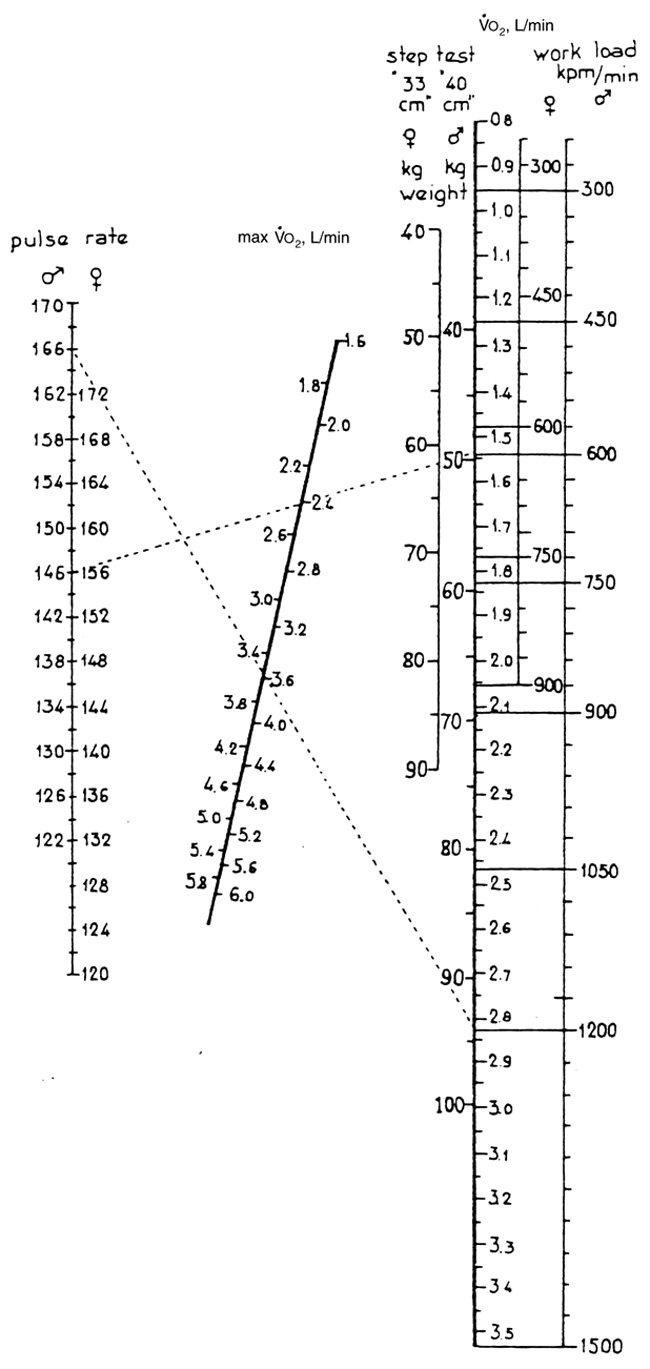The Astrand Test is a submaximal cycle ergometer aerobic fitness test, based on the relationship between heart rate during work and percentage of maximal aerobic capacity. The original test method and nomogram (Åstrand, P.-O. & Ryhming, I., 1954) was later expanded and modified (Åstrand, I., 1960) with a nomogram accounting for men and women of different ages. There are many other cycling tests and aerobic fitness tests, such as the similar YMCA Cycle ergometer submaximal test.
equipment required: cycle ergometer, clock or stopwatch, heart rate monitor, ECG monitor (optional)
pre-test: Explain the test procedures to the subject. Perform screening of health risks and obtain informed consent. Prepare forms and record basic information such as age, height, body weight, gender, test conditions. Calibrate and adjust the cycle ergometer. Attach heart rate monitor. See more details of pre-test procedures.
description: Allow the subject to warm‐up on the cycle ergometer for 2 to 3 minutes with a resistance of 0 kg and at a cadence of 50. Following this, the subject pedals for 6 minutes at a workload chosen to try and elicit a steady-state heart rate between 125 and 170 bpm. As a guide, the initial workload for men is between 300-600 kp/m/min (unconditioned) and 600-900 (conditioned). For women, 300-450 kp/m/min (unconditioned) and 450-600 (conditioned). Record heart rate every minute during the test. If the heart rate at 5 and 6 minutes is not within 5 beats/min, continue for one extra minute. If the steady-state heart rate achieved is not between 125 and 170 bpm, adjust the workload appropriately and continue for a second 6 minute period. Otherwise, the test is completed.
scoring (nomogram): Generally the lower the steady-state heart rate the better your fitness. The steady-state heart rate and workload are looked up on the nomogram to determine an estimation of VO2max.
 Astrand scoring nomogram (Åstrand, I., 1960)
Astrand scoring nomogram (Åstrand, I., 1960) scoring (formula): Here is also the formula (Buono et al. 1989) that the nomogram is based on, where predicted VO2max is in L/min, HRss is the steady heart rate after 6 min of exercise, and the workload in kg.m/min. To convert a load in watts to kg.m/min, multiply the watts by 6.12.
females: VO2max = (0.00193 x workload + 0.326) / (0.769 x HRss - 56.1) x 100
males: VO2max = (0.00212 x workload + 0.299) / (0.769 x HRss - 48.5) x 100
age correction: There is an age correction factor to adjust the score depending on the age of the subject. Extrapolate the correction factor for ages between those listed.
| Age | Correction Factor |
|---|---|
| 15 | 1.10 |
| 25 | 1.00 |
| 35 | 0.87 |
| 40 | 0.83 |
| 45 | 0.78 |
| 50 | 0.75 |
| 55 | 0.71 |
| 60 | 0.68 |
| 65 | 0.65 |
validity: the correlation to VO2max is approximately 0.85 - 0.90.
advantages: this is a simple test to administer, reasonably accurate and appropriate for ECG monitoring during exercise.
disadvantages: the test score would be influenced by the variability in maximum heart rate in individuals. It would underestimate the fitness of those with a high maximum heart rate, and overestimate fitness with advancing age (as max HR reduces with age). As it is performed on a cycle ergometer, it would favor cyclists.
references:
- Åstrand, I. (1960) "Aerobic work capacity in men and women with special reference to age". Acta Physiologica Scandinavica, vol. 49, suppl 169.
- Astrand PO, Rodahl K. Text Book of Work Physiology: Physiological basis of exercise. New York: McGraw Hill, 1986.
- Åstrand, P.-O. & Ryhming, I. (1954) "A nomogram for calculation of aerobic capacity (physical fitness) from pulse rate during submaximal work." J Appl Physiol, 7, page 218-221.
- Buono MJ, Roby JJ, Micale FG, Sallis JF. Predicting maximal oxygen uptake in children: modification of the Astrand-Ryhming test. Pediatric Exercise Science 1989;1:278-283.
- RE Cink and TR Thomas, Validity of the Astrand-Ryhming nomogram for predicting maximal oxygen intake. British Journal of Sports Medicine, 1981, Vol 15, Issue 3 182-185.
- Legge and Banister, The Astrand-Rhyming nomogram revisited J Appl Physiol.1986; 61: 1203-1209.
Similar Tests
Related Pages
- Fitness tests for cyclists
- Cycling Fitness Tests, assessments involving cycling exercise.
- Cycle Ergometers
- Other aerobic fitness tests
- More information on measuring heart rate
- Profile of Per-Olof Åstrand


 Current Events
Current Events